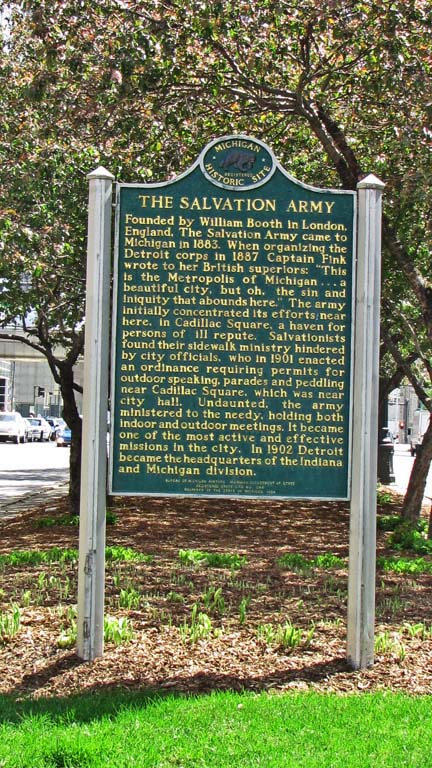

William Booth became a Methodist minister in London in 1852. He quickly realized that as cities developed in the new industrial age, they came to include many individuals who were impoverished. That is, cities always had poor residents but as cities grew rapidly, new groups of poor also developed including women who lost their husbands in industrial accidents, people who came from the countryside but could not adjust to city life, orphans who lost parents and people who drank too much or suffered from mental problems. Booth devoted himself to these individuals seeking to provide them with both spiritual guidance and the food and shelter they needed.
In 1865, he founded the Salvation Army as a faith-based organization that would address the needs of the urban poor and those who were despised or disregarded by respectable citizens, such as thieves, gamblers, drunkards, commercial sex workers and drifters. Most organized churches did not specialize in caring for the needs of these outcast people, but the Salvation Army did. The Salvation Army came to the United States in 1880 when a group outpost of members began serving the needs of what we might call the “underclass” population of New York City. In 1887, the first Salvation Army post was established in Detroit.
Although Salvation Army members saw themselves as carrying out the instructions laid out in the Gospels, especially the Beatitudes, they were not always appreciated. For one thing, they were emphasizing the downside and human costs of the new industrial era. Indeed, when you read the description of urban life in the late Nineteenth Century, you get the impression that there were very many impoverished children and widows and numerous petty criminals of many different kinds in all of the large cities. The Salvation Army publicized these human tragedies and sought to remedy them in their distinctly Christian way. Of course, in this era there were few publically-supported welfare programs or institutions focused upon the needs of the impoverished. Some cities established orphanages and poor houses for the penniless elderly but they were very dreary places resembling prisons. In addition some critics accused the Salvation Army of providing too many services for poor and of encouraging the poor to locate near Salvation Army service points. Perhaps if the impoverished, thieves, prostitutes, orphans and inebriates others didn’t get so much help from the Salvation Army, they would go away instead of congregating in downtown shopping areas.
In Detroit, the Salvation Army provided services in the Campus Martius area. About 1902, Common Council in Detroit enacted what was known as the Campus Ordinance. It specified that “No man may make a speech or blow a horn or beat a drum within one-half mile of city hall.” At that time, Detroit’s city hall was located at facing Campus Martius on the land now occupied by Bank One Michigan at 611 Woodward. This was the magnificent elaborate baroque building that James Anderson designed in 1861, but because of the Civil War, the cornerstone was not laid until 1868 with a grand opening on July 4, 1871. This is one of the Detroit’s architectural treasures of the pre-industrial era that has been lost. Art patron Bela Hubbard commissioned the city’s leading sculptor, Julius Theodore Melchers to carve impressive statues of Antoine Cadillac, Father Jacques Marquette, Father Gabriel Richard and Sieur de la Salle. Fortunately they have been preserved and are now on display on the Wayne State University Campus at Ludington Place.
Colonel Blanche Cox commanded Detroit’s Salvation Army post at that time. She and her fellow members continued to follow the dictates of the Gospel as they interpreted them, city ordinance notwithstanding. They preached to the urban poor after attracting them to Campus Martius with the traditional music of the Corp: tambourines, brass horns and drums. Twelve times Colonel Cox was arrested for violating the Campus Ordinance and eleven times she served terms in jail rather than paying a fine.
James H. Scripps founded The Detroit News. He became rich with that endeavor and joined the ranks of the nation’s leading publishers. He thought that it was ridiculous that the Detroit’s Common Council jailed Salvation Army members for providing services for the poor. He made this a front page issue and initiated a campaign to repeal the Campus Ordinance. Finally, Common Council decided to repeal the law.
If such an ordinance were put on the law books today, there would be much controversy about religious freedom and First Amendment speech rights. I do not know if there was any litigation about the Campus Ordinance but, I infer, it was not on the books for more than a year or so.
The Salvation Army continues to have a major presence in Detroit, providing assistance to a new generation of impoverished individuals.
Website for Salvation Army in Detroit area: http://www.usc.salvationarmy.org/usc/www_usc_emi.nsf
State of Michigan Registry of Historic Sites: P3, 214, Listed February 17, 1994
State of Michigan Historical Marker: Put in place: March 8, 1994
Photograph: Ren Farley; April 18, 2012
Description prepared: July, 2012
Return to Religious Sites
Return to Homepage